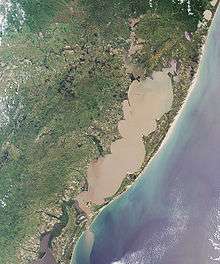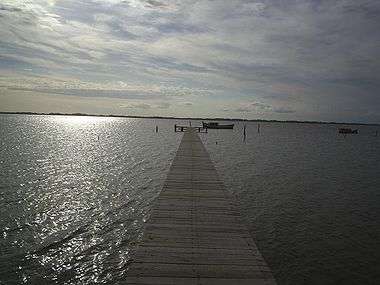Lagoa dos Patos

Lagoa dos Patos (Portuguese pronunciation: [laˈɡo(w).ɐ dus ˈpatus]; English: Ducks' Lagoon) is the second largest lagoon in Latin America and the biggest in Brazil. It is located in the state of Rio Grande do Sul, southern Brazil. It is 174 miles (280 km) long, has a maximum width of 44 miles (70 km), and a total area of 3,803 sq. mi. (9,850 km2). It is separated from the Atlantic Ocean by a sandbar about 5 miles (8 kilometers) wide. The navigable São Gonçalo Channel, which enters Lagoa dos Patos near the town of Pelotas, connects Lagoa dos Patos to Lagoa Mirim to the south. The Rio Grande, at the south end of Lagoa dos Patos, forms the outlet to the Atlantic.
The most accepted etymology is that the name "Patos" comes from an indigenous tribe that used to live in the area when the Europeans arrived.
This lagoon is evidently the remains of an ancient depression in the coastline shut in by sand beaches built up by the combined action of wind and current. It is at sea level, but its waters are affected by the tides and are brackish only a short distance above the Rio Grande outlet.
The lagoon's largest and most fertile island is the Ilha dos Marinheiros, which is located near the eastern shore. The island is geopolitically part of the municipality of Rio Grande.
Waters of the lagoon hosts rich bio-diversities, even including some of top predators and supreme species of ocean ecosystem such as boto (focusing on Tursiops truncatusin this case)[1][2] and southern right whales.[3][4]
Towns and cities on coast
| Wikimedia Commons has media related to Lagoa dos Patos. |

Coordinates: 31°06′S 51°15′W / 31.100°S 51.250°W
References
- ↑ http://botosdalagoa.com.br/
- ↑ http://g1.globo.com/rs/rio-grande-do-sul/nossa-terra/2013/noticia/2013/04/projeto-de-universidade-monitora-golfinhos-em-rio-grande-no-rs.html
- ↑ http://zh.clicrbs.com.br/rs/noticias/noticia/2014/09/baleias-se-perdem-e-param-na-lagoa-dos-patos-no-rio-grande-do-sul-4595920.html
- ↑ http://www.jornalagora.com.br/site/content/noticias/detalhe.php?e=3&n=63408